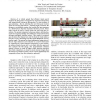727 search results - page 107 / 146 » On Bayesian model and variable selection using MCMC |
JMLR
2010
14 years 4 months ago
2010
Real stochastic processes operating in continuous time can be modeled by sets of stochastic differential equations. On the other hand, several popular model families, including hi...
110
click to vote
BMVC
2010
14 years 7 months ago
2010
In this paper, we propose a framework for predicting the performance of a vision algorithm given the input image or video so as to maximize the algorithm's ability to provide...
NIPS
2001
14 years 11 months ago
2001
This paper presents an unsupervised learning algorithm that can derive the probabilistic dependence structure of parts of an object (a moving human body in our examples) automatic...
ICRA
2008
IEEE
15 years 4 months ago
2008
IEEE
— It is widely agreed that efficient visual search requires the integration of target-driven top-down information and image-driven bottom-up information. Yet the problem of gaze...
145
click to vote
CVPR
2009
IEEE
16 years 4 months ago
2009
IEEE
A Bayesian marked point process (MPP) model is developed
to detect and count people in crowded scenes. The
model couples a spatial stochastic process governing number
and placem...

